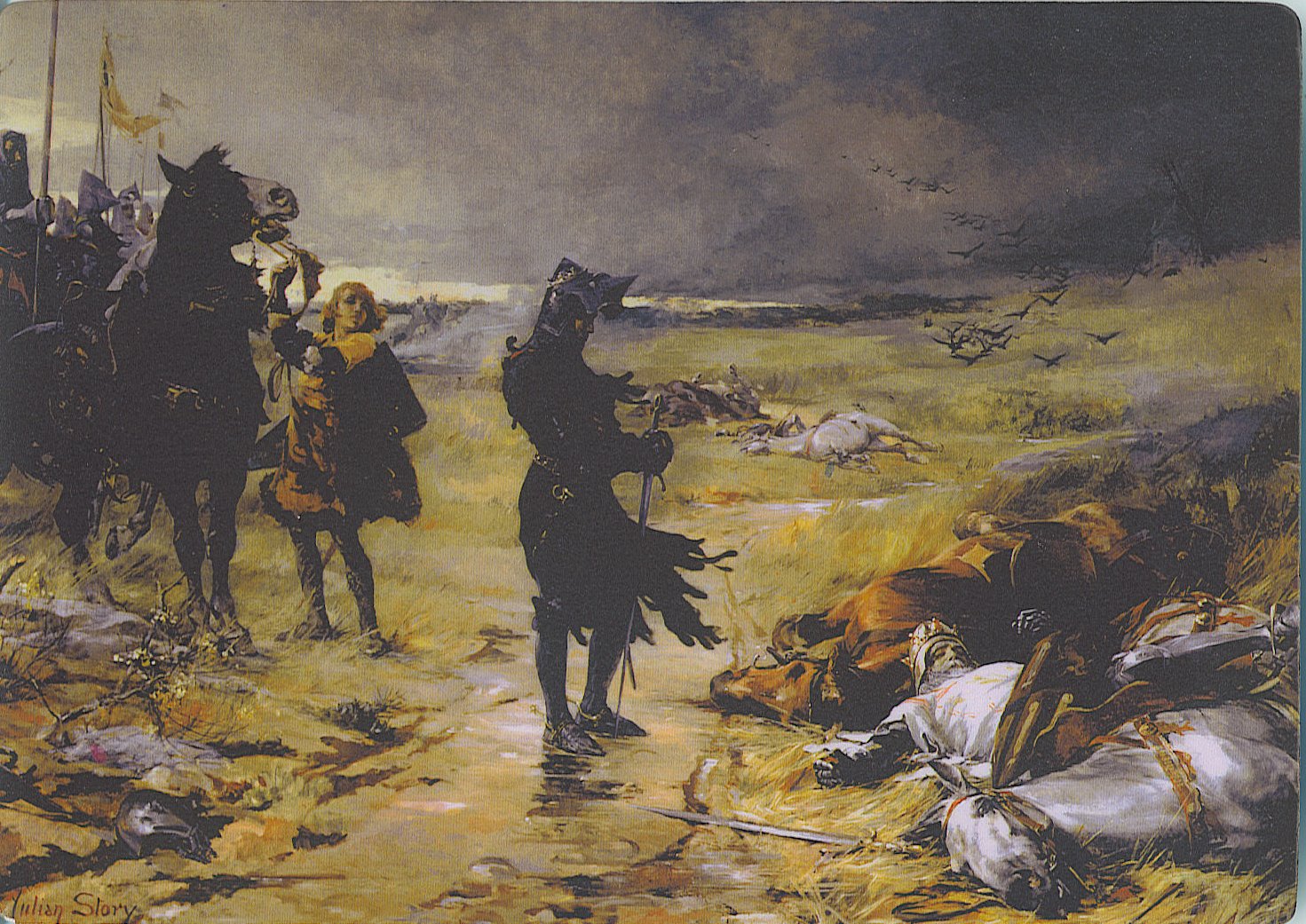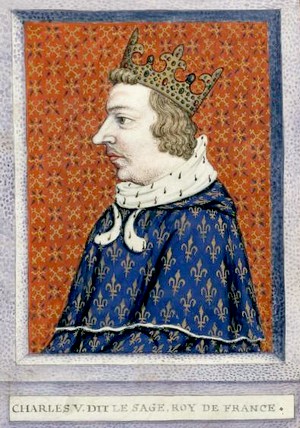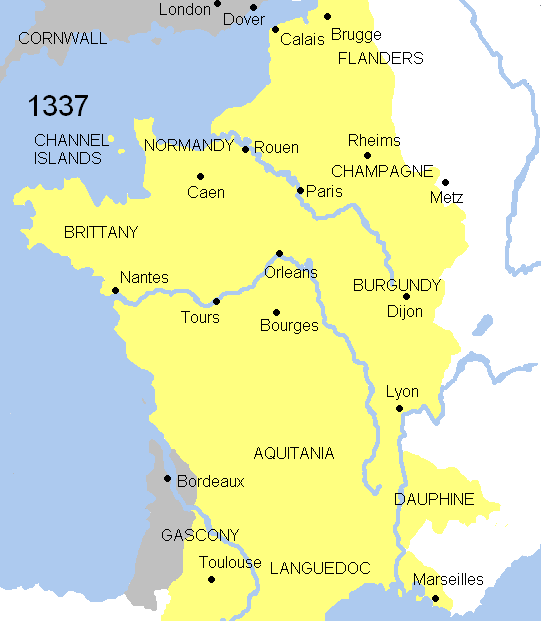|
Louis I, Duke Of Anjou
Louis I, Duke of Anjou (23 July 1339 – 20 September 1384) was a French prince, the second son of John II of France and Bonne of Bohemia. His career was markedly unsuccessful. Born at the Château de Vincennes, Louis was the first of the Angevin branch of the Valois royal house. His father appointed him Count of Anjou and Count of Maine in 1356, and then raised him to the title Duke of Anjou in 1360 and Duke of Touraine in 1370. He fought in the Battle of Poitiers (1356), in which his father the king was captured by the English. In 1360, he was one of a group of hostages the French surrendered to the English in exchange for the king. He escaped from England, after which his father felt bound in honour to return to English custody, where he later died. In 1382, as the adopted son of Joanna I of Naples, he succeeded to the counties of Provence and Forcalquier. He also inherited from her a claim to the kingdoms of Naples and Jerusalem. He was already a veteran of the Hund ... [...More Info...] [...Related Items...] OR: [Wikipedia] [Google] [Baidu] |
Count Of Anjou
The Count of Anjou was the ruler of the County of Anjou, first granted by King Charles the Bald, Charles the Bald of West Francia in the 9th century to Robert the Strong. Ingelger and his son, Fulk the Red, were viscounts until Fulk assumed the title of count. Ingelger's male line ended with Geoffrey II, Count of Anjou, Geoffrey II. Subsequent counts of Anjou were descended from Geoffrey's sister Ermengarde of Anjou, Duchess of Burgundy, Ermengarde and Count Geoffrey II of Gâtinais. Their agnatic descendants, who included the Angevin kings of England, continued to hold the title and territory until King Philip II Augustus seized the region and annexed it to the French royal domain, French crown lands. In 1360, the county was raised to a dukedom becoming known as Duke of Anjou, subsequently leading the Duchy of Anjou. The title was held by Philip V of Spain before his accession to the throne in 1700. Since then, some Spanish Legitimist claimants to the French throne also claim t ... [...More Info...] [...Related Items...] OR: [Wikipedia] [Google] [Baidu] |
Battle Of Poitiers (1356)
The Battle of Poitiers was fought on 19September 1356 between a French army commanded by King JohnII and an Anglo- Gascon force under Edward, the Black Prince, during the Hundred Years' War. It took place in western France, south of Poitiers, when approximately 14,000 to 16,000 French attacked a strong defensive position held by 6,000 Anglo-Gascons. Nineteen years after the start of the war, the Black Prince, eldest son and heir of the English King, set out on a major campaign in south-west France. His army marched from Bergerac to the River Loire, which they were unable to cross. John gathered a large and unusually mobile army and pursued Edward's forces. The Anglo-Gascons had by this point established a strong defensive position near Poitiers, and after unsuccessful negotiations between the two sides, were attacked by the French. The first assault included two units of heavily armoured cavalry, a strong force of crossbowmen as well as many infantry and dismounted men-at ... [...More Info...] [...Related Items...] OR: [Wikipedia] [Google] [Baidu] |
Edward III Of England
Edward III (13 November 1312 – 21 June 1377), also known as Edward of Windsor before his accession, was King of England from January 1327 until his death in 1377. He is noted for his military success and for restoring royal authority after the disastrous and unorthodox reign of his father, Edward II. Edward III transformed the Kingdom of England into one of the most formidable military powers in Europe. His fifty-year reign is List of monarchs in Britain by length of reign#Ten longest-reigning British monarchs, one of the longest in English history, and saw vital developments in legislation and government, in particular the evolution of the English Parliament, as well as the ravages of the Black Death. He outlived his eldest son, Edward the Black Prince, and was succeeded by his grandson, Richard II. Edward was crowned at age fourteen after his father was deposed by his mother, Isabella of France, and her lover, Roger Mortimer, 1st Earl of March, Roger Mortimer. At the age of ... [...More Info...] [...Related Items...] OR: [Wikipedia] [Google] [Baidu] |
Treaty Of Brétigny
A treaty is a formal, legally binding written agreement between sovereign states and/or international organizations that is governed by international law. A treaty may also be known as an international agreement, protocol, covenant, convention, pact, or exchange of letters, among other terms; however, only documents that are legally binding on the parties are considered treaties under international law. Treaties may be bilateral (between two countries) or multilateral (involving more than two countries). Treaties are among the earliest manifestations of international relations; the first known example is a border agreement between the Sumerian city-states of Lagash and Umma around 3100 BC. International agreements were used in some form by most major civilizations and became increasingly common and more sophisticated during the early modern era. The early 19th century saw developments in diplomacy, foreign policy, and international law reflected by the widespread use of tr ... [...More Info...] [...Related Items...] OR: [Wikipedia] [Google] [Baidu] |
England In The Middle Ages
England in the Middle Ages concerns the history of England during the Middle Ages, medieval period, from the end of the 5th century through to the start of the Early modern Britain, early modern period in 1485. When England emerged from the collapse of the Roman Empire, the Economy of England in the Middle Ages, economy was in tatters and many of the towns abandoned. After several centuries of Germanic immigration, new identities and cultures began to emerge, developing into kingdoms that competed for power. A rich Anglo-Saxon art, artistic culture flourished under the Anglo-Saxons, producing Epic poetry, epic poems such as ''Beowulf'' and sophisticated metalwork. The Anglo-Saxons converted to Christianity in the 7th century, and a network of monastery, monasteries and convents were built across England. In the 8th and 9th centuries, England faced fierce Viking attacks, and the fighting lasted for many decades. Eventually, Wessex was established as the most powerful kingdom and ... [...More Info...] [...Related Items...] OR: [Wikipedia] [Google] [Baidu] |
France In The Middle Ages
The Kingdom of France in the Middle Ages (roughly, from the 10th century to the middle of the 15th century) was marked by the fragmentation of the Carolingian Empire and West Francia (843–987); the expansion of royal control by the House of Capet (987–1328), including their struggles with the virtually independent principalities (duchies and counties, such as the Normandy#Norman expansion, Norman and County of Anjou, Angevin regions), and the creation and extension of administrative/state control (notably under Philip II of France, Philip II Augustus and Louis IX of France, Louis IX) in the 13th century; and the rise of the House of Valois (1328–1589), including the protracted dynastic crisis against the House of Plantagenet and their Angevin Empire, culminating in the Hundred Years' War (1337–1453) (compounded by the catastrophic Black Death in 1348), which laid the seeds for a more centralized and expanded state in the Early modern France, early modern period and the cr ... [...More Info...] [...Related Items...] OR: [Wikipedia] [Google] [Baidu] |
Edward, The Black Prince
Edward of Woodstock (15 June 1330 – 8 June 1376), known as the Black Prince, was the eldest son and heir apparent of King Edward III of England. He died before his father and so his son, Richard II of England, Richard II, succession to the British throne, succeeded to the throne instead. Edward nevertheless earned distinction as one of the most successful English commanders during the Hundred Years' War, being regarded by his English contemporaries as a model of chivalry and one of the greatest knights of his age. Edward was made Duke of Cornwall, the first English dukedom, in 1337. He was guardian of the kingdom in his father's absence in 1338, 1340, and 1342. He was created Prince of Wales in 1343 and knighted by his father at Saint-Vaast-la-Hougue, La Hougue in 1346. In 1346, Prince Edward commanded the vanguard at the Battle of Crécy, his father intentionally leaving him to win the battle. He took part in Edward III's Battle of Calais, 1349 Calais expedition. In 1355, he ... [...More Info...] [...Related Items...] OR: [Wikipedia] [Google] [Baidu] |
Philip II, Duke Of Burgundy
Philip II the Bold (; ; 17 January 1342 – 27 April 1404) was Duke of Burgundy and ''jure uxoris'' Count of Flanders, Artois and Burgundy. He was the fourth and youngest son of King John II of France and Bonne of Luxembourg. Philip was the founder of the Burgundian branch of the House of Valois. His vast collection of territories made him the undisputed premier peer of the Kingdom of France and made his successors formidable subjects, and later rivals, of the kings of France. Philip played an important role in the development of gunpowder artillery in European warfare, making extensive and successful use of it in his military campaigns. By political marriage, from 1384 Philip gained control over Flanders, one of the most wealthy provinces of Europe in that time. He and his successors ruled it until 1482. This period is referred to as the Burgundian Netherlands. Early life Philip was born in Pontoise in 1342 to John and Bonne of Luxembourg. His father, John, was the eldes ... [...More Info...] [...Related Items...] OR: [Wikipedia] [Google] [Baidu] |
Charles V Of France
Charles V (21 January 1338 – 16 September 1380), called the Wise (; ), was King of France from 1364 to his death in 1380. His reign marked an early high point for France during the Hundred Years' War as his armies recovered much of the territory held by the English and successfully reversed the military losses of his predecessors. Charles became regent of France when his father John II of France, John II was captured by the English at the Battle of Poitiers in 1356. To pay for the defense of the kingdom, Charles raised taxes. As a result, he faced hostility from the French nobility, nobility, led by Charles II of Navarre, Charles the Bad, List of Navarrese monarchs, King of Navarre; the opposition of the French bourgeoisie, which was channeled through the Estates General (France), Estates-General led by Étienne Marcel; and with a peasant revolt known as the Jacquerie. Charles overcame all of these rebellions, but in order to liberate his father, he had to conclude the Treaty ... [...More Info...] [...Related Items...] OR: [Wikipedia] [Google] [Baidu] |
Hundred Years' War
The Hundred Years' War (; 1337–1453) was a conflict between the kingdoms of Kingdom of England, England and Kingdom of France, France and a civil war in France during the Late Middle Ages. It emerged from feudal disputes over the Duchy of Aquitaine and was triggered by English claims to the French throne, a claim to the French throne made by Edward III of England. The war grew into a broader military, economic, and political struggle involving factions from across Western Europe, fuelled by emerging nationalism on both sides. The periodisation of the war typically charts it as taking place over 116 years. However, it was an intermittent conflict which was frequently interrupted by external factors, such as the Black Death, and several years of truces. The Hundred Years' War was a significant conflict in the Middle Ages. During the war, five generations of kings from two rival Dynasty, dynasties fought for the throne of France, then the wealthiest and most populous kingd ... [...More Info...] [...Related Items...] OR: [Wikipedia] [Google] [Baidu] |
Kingdom Of Jerusalem
The Kingdom of Jerusalem, also known as the Crusader Kingdom, was one of the Crusader states established in the Levant immediately after the First Crusade. It lasted for almost two hundred years, from the accession of Godfrey of Bouillon in 1099 until the Siege of Acre (1291), fall of Acre in 1291. Its history is divided into two periods with a brief interruption in its existence, beginning with its collapse after the Siege of Jerusalem (1187), siege of Jerusalem in 1187 and its restoration after the Third Crusade in 1192. The original Kingdom of Jerusalem lasted from 1099 to 1187 before being almost entirely overrun by the Ayyubid dynasty, Ayyubid Sultanate under Saladin. Following the Third Crusade, it was re-established in Acre, Israel, Acre in 1192. The re-established state is commonly known as the "Second Kingdom of Jerusalem" or, alternatively, as the "Kingdom of Acre" after its new capital city. Acre remained the capital for the rest of its existence, even during the tw ... [...More Info...] [...Related Items...] OR: [Wikipedia] [Google] [Baidu] |
Kingdom Of Naples
The Kingdom of Naples (; ; ), officially the Kingdom of Sicily, was a state that ruled the part of the Italian Peninsula south of the Papal States between 1282 and 1816. It was established by the War of the Sicilian Vespers (1282–1302). Until then, the island of Sicily and southern Italy had constituted the "Kingdom of Sicily". When the island of Sicily revolted and was conquered by the Crown of Aragon, it become a separate kingdom also called the Kingdom of Sicily. This left the Neapolitan mainland in the possession of Charles of Anjou who continued to use the name "Kingdom of Sicily". Later, two competing lines of the Angevin family competed for the Kingdom of Naples in the late 14th century, which resulted in the murder of Joanna I at the hands of her successor, Charles III of Naples. Charles' daughter Joanna II adopted King Alfonso V of Aragon as heir, who would then unite Naples into his Aragonese dominions in 1442. As part of the Italian Wars, France briefly r ... [...More Info...] [...Related Items...] OR: [Wikipedia] [Google] [Baidu] |







